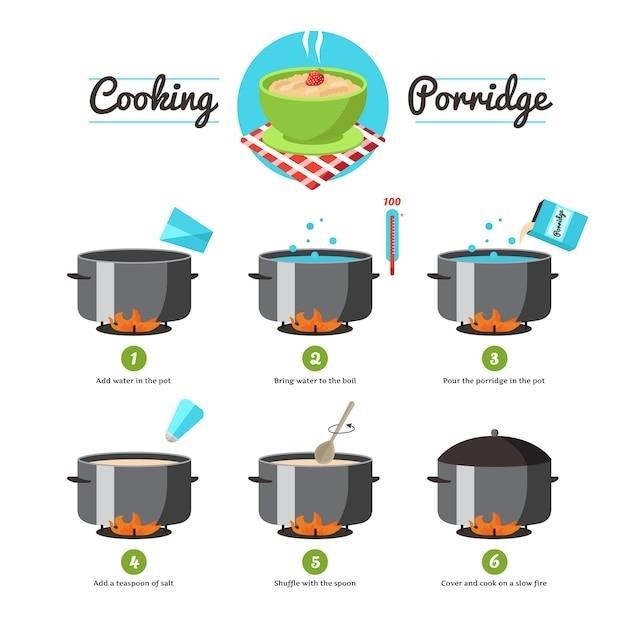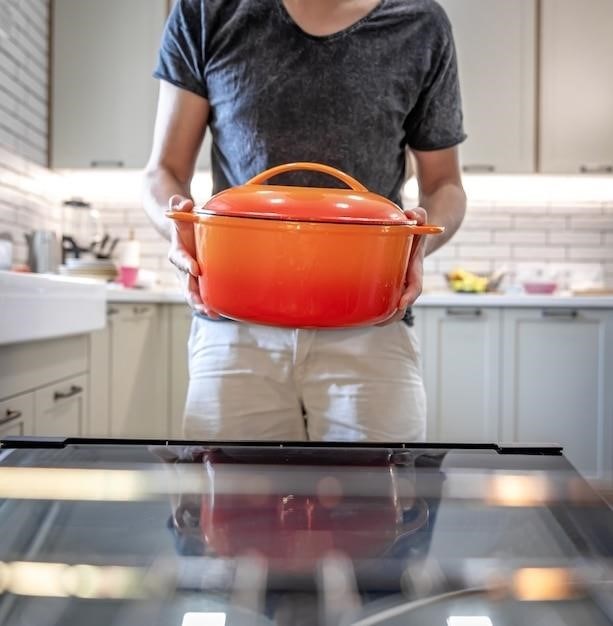Slow Cooker User Manual⁚ A Comprehensive Guide
This comprehensive guide will walk you through everything you need to know about using a slow cooker, from understanding the basics to troubleshooting common issues. Whether you’re a first-time user or an experienced cook, this manual will help you get the most out of your slow cooker and create delicious, hassle-free meals.
Introduction
Welcome to the world of slow cooking! This user manual is your guide to unlocking the potential of your slow cooker, a kitchen appliance that transforms meal preparation into a stress-free experience. Imagine coming home to a delicious, home-cooked meal after a long day, with minimal effort on your part. That’s the magic of slow cooking. Whether you’re a seasoned chef or a cooking novice, this manual will empower you to master the art of slow cooking, creating flavorful and hearty dishes that your family and friends will adore.
Understanding Slow Cooker Basics
At its core, a slow cooker is a simple yet versatile appliance designed to cook food slowly and gently over extended periods. This method of cooking allows flavors to meld and develop, resulting in incredibly tender and flavorful dishes. The slow cooker’s ability to maintain a consistent low temperature ensures even cooking, eliminating the risk of burning or overcooking. The beauty of slow cooking lies in its convenience. You can simply add your ingredients, set the timer, and go about your day; The slow cooker will do the rest, freeing you from the kitchen and allowing you to focus on other tasks. The slow cooker is a true kitchen workhorse, ideal for creating a wide range of dishes, from hearty stews and soups to tender roasts and flavorful dips.
Types of Slow Cookers
Slow cookers come in a variety of styles, each offering unique features and functionalities to suit different cooking needs and preferences. Manual slow cookers are the most basic type, featuring simple on/off switches and temperature settings, typically low, high, and warm. Programmable slow cookers offer greater control and flexibility, allowing you to set specific cooking times and temperatures for your meals. These models often include timers and automatic shut-off functions for convenient cooking. Smart slow cookers take convenience to the next level, connecting to your smartphone or other smart devices. They allow you to remotely control cooking settings, monitor progress, and even receive notifications when your meal is ready. Some smart slow cookers even offer pre-programmed recipes and customizable settings, making it easier than ever to cook delicious meals.
Manual Slow Cookers
Manual slow cookers are the simplest and most traditional type of slow cooker. They typically feature a simple on/off switch and a few basic temperature settings, such as low, high, and warm. These slow cookers are ideal for those who prefer a hands-off approach to cooking, as they require minimal interaction once the food is added. The low and high settings allow you to adjust the cooking temperature to suit different recipes, while the warm setting keeps your food at a safe temperature until you’re ready to serve. Manual slow cookers are also very affordable and widely available, making them a great option for budget-conscious cooks. Their simplicity and reliability have made them a popular choice for generations of cooks, and they continue to be a staple in many kitchens.
Programmable Slow Cookers
Programmable slow cookers offer a level of convenience and flexibility that manual slow cookers lack. These models allow you to set a specific cooking time and temperature in advance, so your meal will be ready at the exact time you need it. This feature is particularly helpful for busy individuals or families who need to plan meals ahead of time. Many programmable slow cookers also include additional features such as a timer, a keep-warm setting, and a delay start function. The timer allows you to set a specific cooking duration, while the keep-warm setting ensures your food stays at a safe temperature after cooking is complete. The delay start function enables you to program the slow cooker to begin cooking at a later time, ideal for preparing meals while you are away from home. With their advanced features, programmable slow cookers are a great option for those who want to make cooking easier and more efficient.
Smart Slow Cookers
Smart slow cookers are the latest evolution in slow cooker technology, seamlessly integrating with your smart home ecosystem. These innovative devices offer unparalleled control and convenience, allowing you to monitor and manage your cooking process remotely. Connected to your smartphone or smart home hub, smart slow cookers empower you to adjust cooking times, temperatures, and settings from anywhere with an internet connection. Some models even come with built-in recipe apps that provide a wide selection of slow cooker recipes and cooking instructions. Beyond remote control, smart slow cookers often feature advanced features like voice control, automated scheduling, and real-time monitoring. They provide a seamless and intuitive user experience, transforming the way you approach slow cooker cooking, making it more efficient and enjoyable.
Slow Cooker Settings and Functions
Slow cookers typically offer a range of settings and functions designed to accommodate different cooking needs. The most common settings are⁚
- High⁚ This setting cooks food at a higher temperature, typically around 200°F (93°C). It is ideal for shorter cooking times, often used for recipes that require a quicker cook, such as stews or pulled pork.
- Low⁚ This setting cooks food at a lower temperature, typically around 170°F (77°C). It’s perfect for longer cooking times, allowing flavors to meld and tenderize tougher cuts of meat; It’s often used for roasts, soups, and chilis.
- Warm⁚ This setting keeps food warm after cooking, allowing you to keep your meal ready to serve without overcooking. It is ideal for holding dishes warm until mealtime or for keeping leftovers fresh.
Some slow cookers also feature additional settings, such as an “auto” setting that automatically switches to the warm setting when the cooking cycle is complete, or programmable timers that allow you to set a delay start time, ensuring your meal is ready when you are.
High Setting
The high setting on your slow cooker is designed for faster cooking times, typically used for recipes that require a shorter cook time, such as stews or pulled pork. This setting generally operates at a temperature around 200°F (93°C).
While the high setting can be convenient for quick meals, keep in mind that it can also lead to overcooked food if not monitored closely. It’s essential to adjust cooking times accordingly, especially for recipes that are typically cooked on low.
If you’re unsure about the appropriate cooking time for your chosen recipe, it’s always recommended to start with a shorter duration and check the food’s doneness before adding more time. This approach will help ensure that your meal turns out perfectly cooked and flavorful.

Low Setting
The low setting on your slow cooker is ideal for long, slow cooking, allowing flavors to meld and tenderize tougher cuts of meat. It typically operates at a temperature around 170°F (77°C), offering a gentle, consistent heat;
This setting is perfect for hearty stews, chilis, and roasts that require extended cooking times. The low setting also helps prevent overcooking, ensuring that your food remains moist and flavorful.

When using the low setting, it’s important to plan ahead, as cooking times can range from several hours to even an entire day. Check your recipe for recommended cooking times and adjust accordingly based on your specific slow cooker model and the ingredients you’re using.
Warm Setting
The warm setting on your slow cooker is designed to keep your food at a safe temperature, preventing it from becoming cold while you wait to serve it. It typically maintains a temperature around 140°F (60°C), which is ideal for keeping dishes like soups, stews, and casseroles warm for hours without overcooking.
You can use the warm setting after your food has finished cooking on the high or low setting, allowing you to keep it ready to serve for extended periods.
The warm setting is also a great option for keeping leftovers safe and enjoyable for later. Simply transfer your cooked food to the slow cooker, turn on the warm setting, and you can enjoy a delicious and convenient meal whenever you’re ready.
Using Your Slow Cooker Safely
Safety is paramount when using any kitchen appliance, and your slow cooker is no exception. To ensure a safe and enjoyable cooking experience, follow these essential guidelines⁚
Read the Manual⁚ Before using your slow cooker for the first time, thoroughly read the manufacturer’s instructions. This will provide specific safety information tailored to your model.
Unplug When Not in Use⁚ Always unplug your slow cooker from the power outlet when not in use, cleaning it, or moving it.
Avoid Contact with Hot Surfaces⁚ The slow cooker’s exterior and cooking pot can become very hot during operation. Always use oven mitts or pot holders when handling these surfaces to prevent burns.
Never Immerse the Base in Water⁚ To prevent electrical shock, ensure the base of the slow cooker never comes into contact with water.
Use a Non-Conductive Surface⁚ Place your slow cooker on a stable, heat-resistant surface, such as a countertop or trivet. Avoid placing it directly on a wooden surface or anything that could be damaged by heat;
Supervise Children⁚ Keep children away from the slow cooker while it is in use.
Cleaning and Maintenance
Regular cleaning and maintenance are essential to keep your slow cooker in top shape and ensure it continues to perform reliably. Here’s a simple guide to follow⁚
Unplug and Cool⁚ Before cleaning, always unplug your slow cooker and allow it to cool completely.
Remove Removable Parts⁚ Detach the cooking pot, lid, and any other removable parts.
Wash with Warm Soapy Water⁚ Wash the cooking pot, lid, and other removable parts in warm, soapy water. Avoid using abrasive cleaners or scouring pads that could scratch the surfaces.
Clean the Base⁚ Wipe down the base of the slow cooker with a damp cloth. If there are any spills or food residue on the base, use a mild cleaning solution and a non-abrasive sponge to remove them.
Dry Thoroughly⁚ Ensure all parts are thoroughly dried before reassembling and storing.
Store Properly⁚ Store your slow cooker in a cool, dry place. Avoid storing it in direct sunlight or near heat sources.
Recipes and Cooking Tips
Slow cookers are incredibly versatile, opening up a world of delicious and convenient meal options. Here are some recipes and tips to help you get started⁚
Classic Slow Cooker Recipes⁚
- Pulled Pork⁚ A crowd-pleasing favorite, slow-cooked pork shoulder is incredibly tender and flavorful.
- Chicken and Dumplings⁚ A comforting and hearty dish, perfect for a chilly evening.
- Beef Stew⁚ Rich and savory, slow-cooked beef stew is a classic for a reason.
Tips for Success⁚
- Brown Meat Before Adding⁚ Browning meat before adding it to the slow cooker enhances the flavor.
- Layer Ingredients⁚ Layer ingredients strategically to ensure even cooking. Place denser ingredients at the bottom and lighter ingredients on top.
- Don’t Overcrowd⁚ Leave some space for liquids and steam to circulate.
- Use a Slow Cooker Liner⁚ A slow cooker liner makes cleanup a breeze, and it prevents food from sticking to the pot.
Enjoy experimenting with different recipes and exploring the endless possibilities of slow cooker cuisine!

Leave a Reply